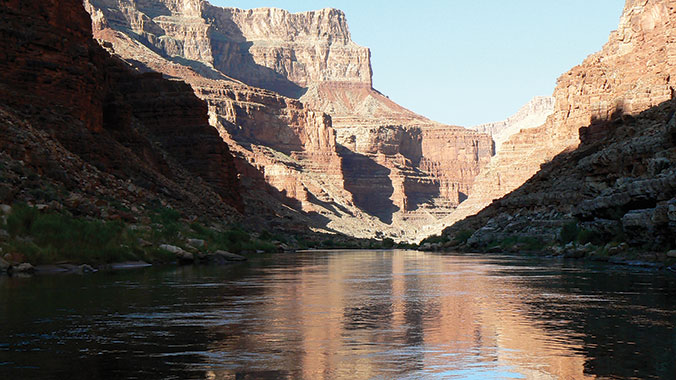Beyond the Hundredth Meridian: John Wesley Powell and the Second Opening of the West
by Stegner, Wallace
Here Wallace Stegner, a Pulitzer Prize-winner, gives us a thrilling account of Powell's struggle against western geography and Washington politics. We witness the successes and frustrations of Powell's distinguished career, and appreciate his unparalleled understanding of the West. "Stegner's most exciting work." (San Francisco Chronicle)
496pp
Carving Grand Canyon: Evidence, Theories, and Mystery
by Ranney, Wayne
Ranney explains how rivers in general can physically carve canyons, looks chronologically at the numerous theories that have been presented by successive generations of geologists regarding the Grand Canyon's formation, and describes a plausible sequence of geologic events that could create such a landscape. Numerous color photographs, detailed illustrations, and maps are provided. Annotation ©2005 Book News, Inc., Portland, OR 160pp; 2nd edition 2012.
I Am the Grand Canyon: The Story of the Havasupai People
by Hirst, Stephen
I Am the Grand Canyon is the story of the Havasupai people. From their origins among the first group of Indians to arrive in North America some 20,000 years ago to their epic struggle to regain traditional lands taken from them in the nineteenth century, the Havasupai have a long and colorful history. The story of this tiny tribe once confined to a too small reservation depicts a people with deep cultural ties to the land, both on their former reservation below the rim of the Grand Canyon and on the surrounding plateaus. 276pp
Living at the Edge: Explorers, Exploiters, and Settlers of the Grand Canyon Region
by Anderson, Michael F
A comprehensive look at the pioneer history of the Grand Canyon Region, from its earliest residents to the creation of the national park at the end of the pioneer era (circa 1920). Included are close to two hundred historic photographs, many never published before, and 12 custom maps of the region. 184pp
Sunk Without a Sound
by Brad Dimock
Grand Canyon, this adventure / mystery / biography details the true story of Glen and Bessie Hyde, who vanished on their 1928 honeymoon river trip through Grand Canyon. When they did not appear at journey's end, Glen's father launched an exhaustive search of Grand Canyon. Although the boat was soon found upright and fully loaded, no trace of the honeymooners was ever found. They had vanished from the face of the earth. Or had they? In the years since, four people appearing to be either Glen or Bessie have emerged, each with a tale implying murder and mayhem. Author and boatman Brad Dimock has unearthed the true story of the Hydes, followed each tale to its source, and gone so far as to retrace the Hydes' fateful voyage in a replica of their archaic scow.
The Emerald Mile
by Kevin Fedarko
In the spring of 1983, massive flooding along the length of the Colorado River confronted a team of engineers at the Glen Canyon Dam with an unprecedented emergency that may have resulted in the most catastrophic dam failure in history. In the midst of this crisis, the decision to launch a small wooden dory named “The Emerald Mile” at the head of the Grand Canyon, just fifteen miles downstream from the Glen Canyon Dam, seemed not just odd, but downright suicidal.
The Emerald Mile, at one time slated to be destroyed, was rescued and brought back to life by Kenton Grua, the man at the oars, who intended to use this flood as a kind of hydraulic sling-shot. The goal was to nail the all-time record for the fastest boat ever propelled—by oar, by motor, or by the grace of God himself—down the entire length of the Colorado River from Lee’s Ferry to Lake Mead. Did he survive? Just barely. Now, this remarkable, epic feat unfolds here, in The Emerald Mile.
The Exploration of the Colorado River and Its Canyons
by Powell, John Wesley
Full text of Powell's 1,000-mile expedition down the fabled Colorado in 1869. Superb account of terrain, geology, vegetation, Indians, famine, mutiny, treacherous rapids, mighty canyons. 240 illustrations. 432pp
The Man Who Walked Through Time: The Story of the First Trip Afoot Through the Grand Canyon
by Fletcher, Colin
The remarkable classic of nature writing by the first man ever to have walked the entire length of the Grand Canyon. 256pp
Unquenchable: America's Water Crisis
by Glennon, Robert
In the middle of the Mojave Desert, Las Vegas casinos use billions of gallons of water for fountains, pirate lagoons, wave machines, and indoor canals. Meanwhile, the town of Orme, Tennessee, must truck in water from Alabama because it has literally run out. Robert Glennon captures the irony—and tragedy—of America’s water crisis in a book that is both frightening and wickedly comical. Unquenchable reveals the heady extravagances and everyday inefficiencies that are sucking the nation dry.
Woman of the River: Georgie White Clark, White-Water Pioneer
by Richard E. Westwood
Georgie White Clark-adventurer, raconteur, eccentric--first came to know the canyons of the Colorado River by swimming portions of them with a single companion. She subsequently hiked and rafted portions of the canyons, increasingly sharing her love of the Colorado River with friends and acquaintances. At first establishing a part-time guide service as a way to support her own river trips, she went on to become perhaps the canyons' best-known river guide, introducing their rapids to many others-on the river, via her large-capacity rubber rafts, and across the nation, via magazine articles and movies. Georgie Clark saw the river and her sport change with the building of Glen Canyon Dam, enormous increases in the popularity of river running, and increased National Park Service regulation of rafting and river guides. Adjusting, though not always easily, to the changes, she helped transform an elite adventure sport into a major tourist activity.
Writing Down the River: Into the Heart of the Grand Canyon
by Collection of Authors
Copious, dramatic color photographs and poetic quotations illustrate these essays describing the whitewater rafting experiences of 15 prominent female writers sent down the Colorado River during the summer of 1997.







